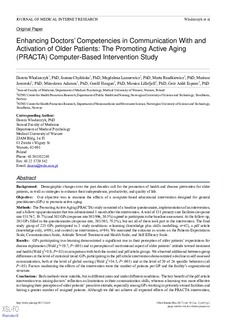| dc.contributor.author | Wlodarczyk, Dorota | |
| dc.contributor.author | Chylińska, Joanna | |
| dc.contributor.author | Lazarewicz, Magdalena Anna | |
| dc.contributor.author | Rzadkiewicz, Marta | |
| dc.contributor.author | Jaworski, Mariusz | |
| dc.contributor.author | Adamus, Miroslawa | |
| dc.contributor.author | Haugan, Gørill | |
| dc.contributor.author | Lillefjell, Monica | |
| dc.contributor.author | Espnes, Geir Arild | |
| dc.date.accessioned | 2018-06-01T12:09:54Z | |
| dc.date.available | 2018-06-01T12:09:54Z | |
| dc.date.created | 2017-01-30T16:02:33Z | |
| dc.date.issued | 2017 | |
| dc.identifier.citation | Journal of Medical Internet Research. 2017, 19 (2), 1-19. | nb_NO |
| dc.identifier.issn | 1438-8871 | |
| dc.identifier.uri | http://hdl.handle.net/11250/2500057 | |
| dc.description.abstract | Background: Demographic changes over the past decades call for the promotion of health and disease prevention for older patients, as well as strategies to enhance their independence, productivity, and quality of life.
Objective: Our objective was to examine the effects of a computer-based educational intervention designed for general practitioners (GPs) to promote active aging.
Methods: The Promoting Active Aging (PRACTA) study consisted of a baseline questionnaire, implementation of an intervention, and a follow-up questionnaire that was administered 1 month after the intervention. A total of 151 primary care facilities (response rate 151/767, 19.7%) and 503 GPs (response rate 503/996, 50.5%) agreed to participate in the baseline assessment. At the follow-up, 393 GPs filled in the questionnaires (response rate, 393/503, 78.1%), but not all of them took part in the intervention. The final study group of 225 GPs participated in 3 study conditions: e-learning (knowledge plus skills modelling, n=42), a pdf article (knowledge only, n=89), and control (no intervention, n=94). We measured the outcome as scores on the Patients Expectations Scale, Communication Scale, Attitude Toward Treatment and Health Scale, and Self-Efficacy Scale.
Results: GPs participating in e-learning demonstrated a significant rise in their perception of older patients’ expectations for disease explanation (Wald χ2=19.7, P<.001) and in perception of motivational aspect of older patients’ attitude toward treatment and health (Wald χ2=8.9, P=.03) in comparison with both the control and pdf article groups. We observed additional between-group differences at the level of statistical trend. GPs participating in the pdf article intervention demonstrated a decline in self-assessed communication, both at the level of global scoring (Wald χ2=34.5, P<.001) and at the level of 20 of 26 specific behaviors (all P<.05). Factors moderating the effects of the intervention were the number of patients per GP and the facility’s organizational structure.
Conclusions: Both methods were suitable, but in different areas and under different conditions. The key benefit of the pdf article intervention was raising doctors’ reflection on limitations in their communication skills, whereas e-learning was more effective in changing their perception of older patients’ proactive attitude, especially among GPs working in privately owned facilities and having a greater number of assigned patients. Although we did not achieve all expected effects of the PRACTA intervention, both its forms seem promising in terms of enhancing the competencies of doctors in communication with and activation of older patients. | nb_NO |
| dc.language.iso | eng | nb_NO |
| dc.publisher | JMIR Publications | nb_NO |
| dc.rights | Navngivelse 4.0 Internasjonal | * |
| dc.rights.uri | http://creativecommons.org/licenses/by/4.0/deed.no | * |
| dc.title | Enhancing GPs’ competencies in communication and activation of the elderly: results from the PRACTA computer-based intervention study | nb_NO |
| dc.type | Journal article | nb_NO |
| dc.type | Peer reviewed | nb_NO |
| dc.description.version | publishedVersion | nb_NO |
| dc.source.pagenumber | 1-19 | nb_NO |
| dc.source.volume | 19 | nb_NO |
| dc.source.journal | Journal of Medical Internet Research | nb_NO |
| dc.source.issue | 2 | nb_NO |
| dc.identifier.doi | 10.2196/jmir.6948 | |
| dc.identifier.cristin | 1441914 | |
| dc.description.localcode | ©Dorota Wlodarczyk, Joanna Chylińska, Magdalena Lazarewicz, Marta Rzadkiewicz, Mariusz Jaworski, Miroslawa Adamus, Gørill Haugan, Monica Lillefjell, Geir Arild Espnes. Originally published in the Journal of Medical Internet Research (http://www.jmir.org), 22.02.2017. This is an open-access article distributed under the terms of the Creative Commons Attribution License (http://creativecommons.org/licenses/by/2.0/), which permits unrestricted use, distribution, and reproduction in any medium, provided the original work, first published in the Journal of Medical Internet Research, is properly cited. The complete bibliographic information, a link to the original publication on http://www.jmir.org/, as well as this copyright and license information must be included. | nb_NO |
| cristin.unitcode | 194,65,20,0 | |
| cristin.unitcode | 194,65,30,0 | |
| cristin.unitname | Institutt for samfunnsmedisin og sykepleie | |
| cristin.unitname | Institutt for nevromedisin og bevegelsesvitenskap | |
| cristin.ispublished | true | |
| cristin.fulltext | original | |
| cristin.qualitycode | 2 | |

